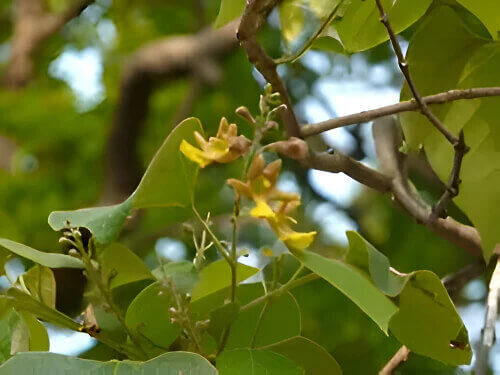- +033 2572 7171
- info@dhanvantary.com

4.5 Rating | 4500 Review

4.5 Rating | 4500 Review
Gmelina arborea is a deciduous trees that attains height up to 20 meters. The bark is grayish white colored, which exfoliates in thin flakes. The leaves are simple, opposite and heart shaped tapering towards the apex with length of 10-25 cm and breadth of 8-20 cm. The flowers are bisexual having reddish to yellow color; resemble to those of vasa flowers.

The fruits are orange yellow colored oval drupes which on ripening give sweetish odor, with 1-2 seeds.
Root pieces are greyish brown and almost cylindrical with irregular surface. It is tough in bark, brittle and predominant in woody portion. The seeds are hard and have oblong surface with smooth, seed coat thin, papery oily in taste.
Kingdom
Plantae
Class
Angiosperms
Sub class
Eudicots
Super order
Asterids
Order
Lamiaceae
Family
Verbinaceae
Genus
Gmelina
Species
G. arborea
Gambhari is native of Pakistan, Bhutan and India and it is globally distributed from Brazil to Indo-Malaysia. Throughout India it is distributed in Deccan Peninsula in Nilgiri, along with eastern and Western Ghats to moist deciduous forests like Himalaya. It is found in Uttar Pradesh, Punjab, Dehra Dun, Orissa, West Bengal, Assam, Madhya Pradesh, Maharashtra, Andhra Pradesh, Karnataka, Kerala and Tamil Nadu, Andaman Islands.
It also grows naturally in Myanmar, Thailand, Laos, Cambodia, Vietnam, and in southern provinces of China, and has been planted widely in Sierra Leone, Nigeria, Malaysia, and on experimental basis in other countries as well.
These trees grow well in moist, fertile soil having good drainage. Its natural reproduction takes place in rainy season after the drupes fall to the ground.
|
Hindi / Sanskrit |
English |
||
|
Rasa |
Tikta, Kashaya, Madhura |
Taste |
Bitter, Astringent, Sweet |
|
Guna |
Guru |
Physical Property |
Heavy |
|
Virya |
Ushna |
Potency |
Hot |
|
Vipaka |
Katu |
Metabolic Property (After Digestion) |
Pungent |
It balances Vata and Pitta Doshas.
|
Charak Samhita |
Sushruta Samhita |
Vagbhata |
|
|
|
